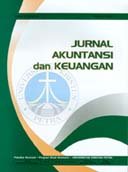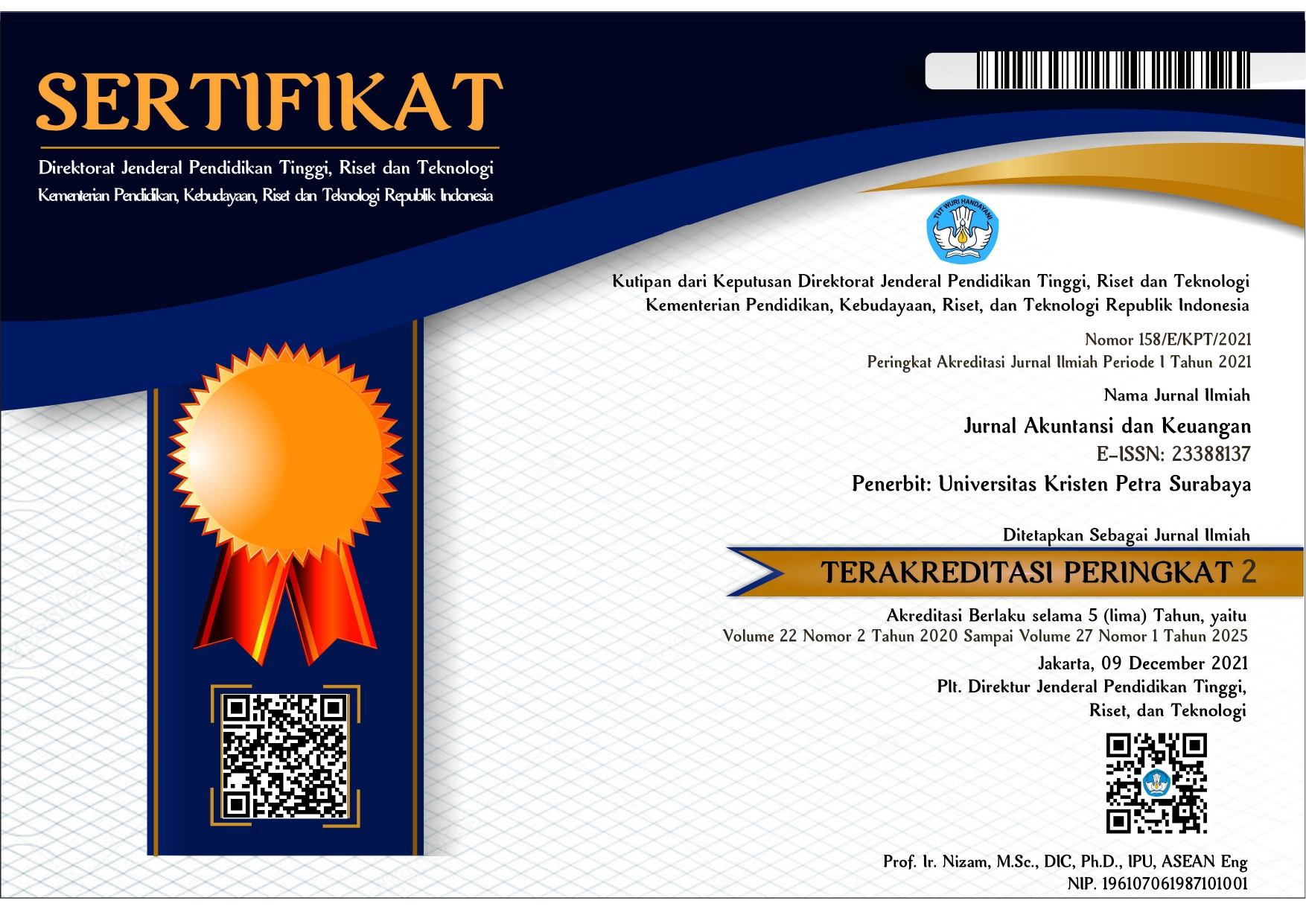Business Strategy and Environmental Performance
DOI:
https://doi.org/10.9744/jak.23.2.95-104Keywords:
Cost Leadership, Differentiation, Environmental Responsibility, PROPERAbstract
Business strategy choices are very influential in a company’s environmental performance. Companies that choose the cost leadership strategy tend to streamline their expenses which leads to them overlooking the environmental cost. Meanwhile, differentiation strategy encourages companies to accommodate environmental costs to fulfill customers’ demands. Therefore, this research aims to examine the impacts of the strategy choices on environmental performance, which has not been focused on by previous researchers. This research’s samples are public companies that are consistently participating in the PROPER program during the 2012-2017 period. 228 company years fulfill the sample criteria. The data are processed using the GRETL application that is fit for processing the panel data. We apply two proxies to measure each strategy choice. Cost leadership is proxied with EPAS and SPPE while differentiation is measured with SGAS and SCGS. This research’s findings are, firstly, companies that choose the cost leadership strategy have lower environmental performances, and, secondly, companies with differentiation strategy have high environmental performances. However, not all proxies used to measure the cost leadership and differentiation strategies support the impacts of strategy choices on environmental responsibilities performance.
References
Allen, R., & Helms, M. (2006). Linking strategic practices and organizational performance to Porter's generic strategies. Business Process Management Journal, 12(4), 433-454.
Anderson, M., Banker, R., Huang, R., & Janakiraman, S. (2007). Cost Behavior and Fundamental Analysis of SG&A Costs. Journal of Accounting, Auditing & Finance, 22(1), 1-28.
Atkin, T., Gilinsky, A., & Newton, S. (2012). Environmental strategy: does it lead to competitive advantage in the US wine industry? International Journal of Wine Business Research, 24(2), 115-133.
Banker, Hu, Pavlou, & Luftman. (2011). CIO Reporting Structure, Strategic Positioning, and Firm Performance. MIS Quarterly, 35(2), 487.
Banker, R., Flasher, R., & Zhang, D. (2013). Strategic Positioning and Asymmetric Cost Behavior. SSRN Electronic Journal.
Berman, S., Wicks, A., Kotha, S., & Jones, T. (1999). Does Stakeholder Orientation Matter? The Relationship Between Stakeholder Management Models and Firm Financial Performance. Academy of Management Journal, 42(5), 488-506.
Biswas, A., & Roy, M. (2015). Green products: an exploratory study on the consumer behaviour in emerging economies of the East. Journal of Cleaner Production, 87, 463-468.
Brammer, S. & S. Pavelin. (2008). Factors Influencing the Quality of Corporate Environmental Disclosure. Business Strategy and the Environment 17, 120-136.
Campbell J. (2007). Why Would Corporations Behave in Socially Responsible Ways? An Institutional Theory of Corporate Social Res-ponsibility. Academy of Management Review 32(3), 946-967.
Chang, S., Wang, T., Huang, S., & Chiu, A. (2013). The Relationship between Organization Strategy, Fixed-Assets Investment and Earnings Quality. Asian Journal of Finance & Accounting, 5(1), 1-7.
Cho, C. H. dan D. M. Patten. (2007). The Role of Environmental Disclosures as Tools of Legitimacy: A Research Note. Accounting, Organizations and Society, 32(7), 639-647.
Chun, Hyunbae, Jung Wook Kim, Randall Morck, et Bernard Yeung. (2008).Creative Destruction and Firm Specific Performance Heterogeneity. Journal of Financial Economics 109-135.
Cinquini, L. & Tennuci, A. (2010). Strategic Management Accounting and Business Strategy: a Loose Coupling? Journal of Accounting & Organizational Change, 6(2), 228-259.
D. Banker, R., Mashruwala, R., & Tripathy, A. (2014). Does a differentiation strategy lead to more sustainable financial performance than a cost leadership strategy? Management Decision, 52(5), 872-896.
David, J., Hwang, Y., Pei, B., & Reneau, J. (2002). The Performance Effects of Congruence Between Product Competitive Strategies and Purchasing Management Design. Management Science, 48(7), 866-885.
Dean Jr, J., W., Brandes, P., & Dharwadkar, R. (1998). Organizational cynicism. The Academy of Management Review, 23(2), 341- 352.
Duanmu, J., Bu, M., & Pittman, R. (2018). Does market competition dampen environmental performance? Evidence from China. Strategic Management Journal, 39(11), 3006-3030
Epstein, M. J.; Wisner, P. S. (2001). Using a Balanced Scorecard to Implement Sustaina¬bility, Environmental Quality Management, 11(2), 1-10.
Feng, T., Cai, D., Wang, D., & Zhang, X. (2016). Environmental management systems and financial performance: The joint effect of switching cost and competitive intensity. Journal of Clean Production,113, 781-791
Fousteris, A., Didaskalou, E., Tsogas, M., & Georgakellos, D. (2018). The Environmental Strategy of Busines as an Option under Recession in Greece. Sustainability,10(12), 43-99.
Gujarati, D.N. 2012, Dasar-dasar Ekonometrika, Terjemahan Mangunsong, R.C, Salemba Empat, buku 2, Edisi 5, Jakarta.
Hamberg, M., Andre Fagerland, E., & Kvamme Nilsen, K. (2013). Founding family firms and the creation of value: Swedish evidence. Managerial Finance, 39(10), 963-978.
Haq, M., (2014). A comparative analysis of qualitative and quantitative research methods and a justification for use of mixed methods in social research. Annual PhD Conference, Uni¬versity of Bradford Business School of Management.
Hasan, A., & Hilman, H., (2017). Influence of differentiation strategy on performance of hotels: The moderating role of environmental munificence. Journal of Business and Retail Management Research, 11(4),150-16.
Hasnawati, S. dan Sawir, A. (2015). Keputusan Keuangan, Ukuran Perusahaan, Struktur Kepemilikan dan Nilai Perusahaan Publik di Indonesia. Jurnal Manajemen dan Kewirausahaan, 17(1), 65-75.
Hambrick C. D., (1983). High Profit Strategies in Mature Capital Goods Industries: A Con¬tingency Approach. The Academy of Management Journal, 26(4), 687-707.
Indonesia Ministry of Environment (2012), “PROPER Program Peniliaian Peringkat Kinerja Perusahaan dalam Pengelolaan Lingkungan Hidup”, Jakarta
Jensen, M. C. (1986). Agency Costs of Free Cash Flow, Corporate Finance, and Takeo¬vers. American Economic Review, 6 (2),323-329.
Kaplan, R.S. & Norton, D.P. (2001). The Strategy Focused Organization: How Balanced Scorecard Companies Thrive in the New Business Environment, Harvard Business School Press, Boston, MA.
Kim, E., Nam, D. & Stimpert, J.L. (2004). Testing the applicability of Porter’s generic strategies in the digital age: a study of Korean cyber malls. Journal of Business Strategies, 21(1), 19-45.
Kim, W.C. & Mauborgne, R. (2005), Blue Ocean Strategy, Harvard Business School Press Boston, MA.
Kotha, S. & A. Nair (1995) ‘Strategy and environment as determinants of performance: Evidence from the Japanese machine tool industry’, Strategic Management Journal, 16(7), 497-518.
Maury, B. (2006). Family ownership and firm performance: Empirical evidence from Western European corporations. Journal of Corporate Finance, 12(2),321-341.
Middleton, A. (2015). Value relevance of firms’ integral environmental performance: Evidence from Russia. Journal of Accounting and Public Policy, 34(2), 204-211.
Miller, A. & Dess, G.G. (1993). Assessing Porter’s (1980) model in terms of its generalizability, accuracy and simplicity. Journal of Management Studies, 30(4), 553-585.
Outubro Nair, Anil & Filer, Larry, (2003). Cointegration of Firm Strategies Within Groups: A Long-Run Analysis of Firm Behavior in the Japanese Steel Industry. Strategic Management Journal, 24(2), 145
Nandakumar, M. K., Ghobadian, A., & Regan, N.O. (2011). Business-level strategy and performance: The moderating affect of environment and structure. Management Decision, 48(6), 907-939.
Orsato, R.J. (2006). Competitive environmental strategies: when does it PAY to be GREEN? California Management Review, 48 (2), 127-43.
Parker, L. D. (2005). Social and environmental accountability research. Accounting, Auditing & Accountability Journal, 18(6), 842-860.
Porter, M.E. (1980), Competitive Strategy: Techniques for Analyzing Industries and Competitors, The Free Press, New York.
Porter, M.E. (1985), Competitive Advantage: Creating and Sustaining Superior Performance, Free Press, New York, NY.
Poutziouris, P., Savva, C.S., & Hadjielias, E. (2015). Family involvement and firm performance: Evidence from UK listed firms. Jour¬nal of family Business Strategy, 6(1),14-32.
Pradana, F. A. & Suzan, L. (2015). Pengaruh struktur kepemilikan, ukuran perusahaan, dan umur perusahaan terhadap pngungkapan corporate social responsibility. Jurnal Akuntansi Fakultas Ekonomi dan Bisnis Universitas Telkom.
Qian, W., and Xing, K. (2018) Linking Environ-mental and Financial Performance for Privately Owned Firms: Some Evidence from Australia, Journal of Small Business Mana¬gement, 56(2), 330-347.
Qiu, Q., Tan, Z., Wang, J., Peng, J., Li, M., Zhan, Z., (2016). Extraction, enumeration and identification methods for monitoring micro-plastics in the environment. Estuar. Coast. Shelf Sci. 176, 102-109.
Rahman, A. dan Haryanto, R. (2013). Pengaruh Strategi Bisnis Terhadap Hubungan manajemen Persediaan dan kinerja Perusahaan (Studi Pada Perusahaan Publik di BEI). Jurnal Ekonomi dan Bisnis, 12(1), 65–74.
Schaltegger, S., and Lüdeke-Freund, F. (2013). Business cases for sustainability. In Encyclo¬pedia of Corporate Social Responsibility, 245–252. Berlin: Springer.
Setiawan, A. S. (2016). Pengaruh Pemilihan Strategi Deferensiasi Terhadap Kinerja Keuangan (Studi Empiris Pada Perusahaan Manufaktur Food & Beverages terdaftar di BEI), Jurnal Akuntansi, 20(1), 104-116.
Shyu, Jonchi. (2011). Family ownership and firm performance: evidence from Taiwanese firms. Internasional Journal of Managerial Finance, 7(4), 397-441
Siregar, I., Lindrianasari; K. (2013). Hubungan Antara Kinerja Lingkungan dan Kinerja Komite Audit dengan Kualitas Pengungkapan Corporate Social Responsibility. Jurnal Akuntansi dan Keuangan. 4(1), 63-84.
Soewarno, N. (2013). Pengaruh strategi bisnis terhadap kinerja manajerial melalui information capital readiness dan sistem pengukuran kinerja. Jurnal Ekonomi dan Bisnis Airlangga, 23(1), 96-111.
Solovida, G.T. and Latan, H. (2017). Linking environmental strategy to environmental performance: Mediation role of environmental management accounting. Sustainability Accounting, Management and Policy Journal, 8(5), 595-619.
Spencer, X. S. Y. Joiner, T. A. & Salmon, S. (2009). Differentiation Strategy, Performance Measurement System and Organizational Performance: Evidence from Australia. International Journal of Business. 14(1): 83–103.
Tanwar, Ritika. (2013). Porter’s Generic Competi-tive Strategies. IOSR Journal of Business and Management (IOSR-JBM) e-ISSN: 2278-487X, p-ISSN: 2319-7668, 15(1), 11-17.
Teeratansirikool, L. Siengthai, S. Badir, Y. and Charoenngam, C. (2013). Competitive Strategies and Firms Performance: The Mediating Role of Performance measurement. International Journal of Productvity and Performance Management. 62(2), 168 – 184.
Thomas, A., Litschert, R.& Ramaswamy, K. (1991). The performance impact of strategy manager coalignment: an empirical examination. Strategic Management Journal, 12(7), 509-522.
Wu, J., Liu, L., & Sulkowski, A. (2010). Environmental disclosure, firm performance, and firm characteristics: An analysis of S&P 100 Firms, Journal of Accounting of Business and Economics, 10(4),72-83.
Downloads
Published
How to Cite
Issue
Section
License
Authors who publish with this journal agree to the following terms:
- Authors retain the copyright and publishing right, and grant the journal right of first publication with the work simultaneously licensed under a Creative Commons Attribution License that allows others to share the work with an acknowledgement of the work's authorship and initial publication in this journal.
- Authors are able to enter into separate, additional contractual arrangements for the non-exclusive distribution of the journal's published version of the work (e.g., post it to an institutional repository or publish it in a book), with an acknowledgement of its initial publication in this journal.
- Authors are permitted and encouraged to post their work online (e.g., in institutional repositories or on their website) followingthe publication of the article, as it can lead to productive exchanges, as well as earlier and greater citation of published work (See The Effect of Open Access).<a href="http://creativecommons.org/lice















